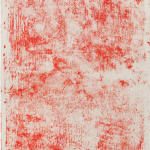Angel Otero Puerto Rico, b. 1981
Untitled (ST-BJ), 2014
Cadmium pigment and silicone on raw canvas
60 x 42 in
152.4 x 106.7 cm
152.4 x 106.7 cm
6122
Further images
Angel Otero begins these silicone paintings by projecting a photographic image, sometimes from his own childhood in Puerto Rico, onto a surface. He then copies that image in silicone and...
Angel Otero begins these silicone paintings by projecting a photographic image, sometimes from his own childhood in Puerto Rico, onto a surface. He then copies that image in silicone and uses that copy as a plate to make a sort of print. He presses the print with raw pigment, such as uncut cadmium or graphite, creating ghostlike images that do not so much resemble the original images as they offer a shadowy, ethereal glimpse at their visual essence.
"Transference" as a gesture is crucial to Angel Otero's entire creative oeuvre, most famously in his "oil skin" paintings in which he transfers oil paint "skins" from glass to canvas, peeling the cured paint off the smooth glass to act like a sculptural or collage material on the surface of canvas. Even while gaining international acclaim for that body of work, Otero continuously experimented with other modes of surface making, including an investigation of pigment transfers that would also operate like large-scale monoprints.
These pigment transfers came into maturity with his 2015 exhibition at Kavi Gupta, titled Lagos. Otero creates a series of line-hatch drawings based on old family photos using silicone caulk on paper. Coating the entire surface in loose pigment dust, Otero then transferred the whole surface to canvas, the process of which forcing the loose pigment to combine with the wet silicone, creating a makeshift paint in the process of transfer, along with loose pigment also staining the unprimed canvas itself. The process ultimately destroys a great deal of the legibility of the image, an outcome Otero specifically wanted- like the elusiveness of fading memories, he wanted these works to have a hazy imperceptibility, where figures are vaguely visible but details are obliterated.
Otero produced most of the works in the series in cadmium red, an important pigment to art history which is being fazed out in the modern era for synthetic alternatives due to the environment impact of cadmium mining. Other works in the series are done with charcoal dust, another medium important to art history, but largely being fazed out of use in the contemporary art world due to its impermanence on paper. Much like the content of the work, the mediums chosen speak to history slipping away.
"Transference" as a gesture is crucial to Angel Otero's entire creative oeuvre, most famously in his "oil skin" paintings in which he transfers oil paint "skins" from glass to canvas, peeling the cured paint off the smooth glass to act like a sculptural or collage material on the surface of canvas. Even while gaining international acclaim for that body of work, Otero continuously experimented with other modes of surface making, including an investigation of pigment transfers that would also operate like large-scale monoprints.
These pigment transfers came into maturity with his 2015 exhibition at Kavi Gupta, titled Lagos. Otero creates a series of line-hatch drawings based on old family photos using silicone caulk on paper. Coating the entire surface in loose pigment dust, Otero then transferred the whole surface to canvas, the process of which forcing the loose pigment to combine with the wet silicone, creating a makeshift paint in the process of transfer, along with loose pigment also staining the unprimed canvas itself. The process ultimately destroys a great deal of the legibility of the image, an outcome Otero specifically wanted- like the elusiveness of fading memories, he wanted these works to have a hazy imperceptibility, where figures are vaguely visible but details are obliterated.
Otero produced most of the works in the series in cadmium red, an important pigment to art history which is being fazed out in the modern era for synthetic alternatives due to the environment impact of cadmium mining. Other works in the series are done with charcoal dust, another medium important to art history, but largely being fazed out of use in the contemporary art world due to its impermanence on paper. Much like the content of the work, the mediums chosen speak to history slipping away.
Provenance
Artist StudioKavi Gupta Gallery





